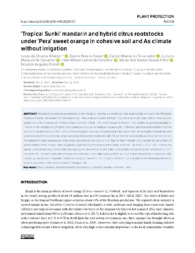'Tropical Sunki' mandarin and hybrid citrus rootstocks under 'Pera' sweet orange in cohesive soil and As climate without irrigation.
'Tropical Sunki' mandarin and hybrid citrus rootstocks under 'Pera' sweet orange in cohesive soil and As climate without irrigation.
Author(s): RIBEIRO, L. de O.; COSTA, D. P.; LEDO, C. A. da S.; CARVALHO, L. M. de; CARVALHO, H. W. L. de; SOARES FILHO, W. dos S.; GIRARDI, E. A.
Summary: The search for alternative rootstocks to the ?Rangpur? lime tree is a challenge to the sustainability of citrus in the Tabuleiros Costeiros (Coastal Tablelands) of Northeastern Brazil. New varieties should meet high drought tolerance with water deficit, cohesive soils, resistance to citrus diseases and inducing high production of fruit. In this work, the performance of ?Pera? sweet orange was evaluated on ?Tropical Sunki? mandarin and 27 hybrid citrus rootstocks in Umbaúba, Sergipe. A local selection of the ?Rangpur? lime was the control. Planting was in 2013 at tree spacing of 6.0 × 3.0 m, without irrigation. Tree size, fruit yield and quality, tree survival rate and graft-compatibility were assessed until 2019. Experimental design was completely randomized blocks with 29 treatments, three replicates and four plants in the plot. Two selection indices were applied to the data to assist in decision making. The ?Tropical Sunki? mandarin induced similar cumulative fruit yield in relation to the ?Rangpur? lime, suggesting a good drought tolerance of the former rootstock. The TSKC × (LCR × TR) - 073 induced slightly lower productivity, compensated by higher productive efficiency and higher concentration of soluble solids, whereas LCR × TR - 001 and HTR - 166 were highly efficient dwarfing rootstocks. The multiplicative and the rank sum indices showed high correlation, both classifying ?Tropical Sunki? mandarin, ?Santa Cruz Rangpur? lime, LVK × LCR - 010 and - 038, HTR - 127, in addition to the three aforementioned hybrids, as superior to the local selection of ?Rangpur? lime.
Publication year: 2021
Types of publication: Journal article
Unit: Embrapa Cassava & Fruits
Keywords: Laranja
Observation
Some of Embrapa's publications are published as ePub files. To read them, use or download one of the following free software options to your computer or mobile device. Android: Google Play Books; IOS: iBooks; Windows and Linux: Calibre.
Access other publications
Access the Agricultural Research Database (BDPA) to consult Embrapa's full library collection and records.
Visit Embrapa Bookstore to purchase books and other publications sold by Embrapa.

